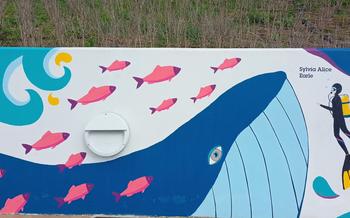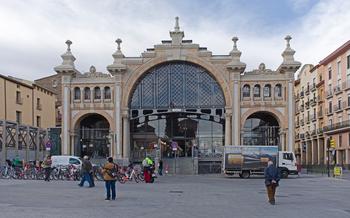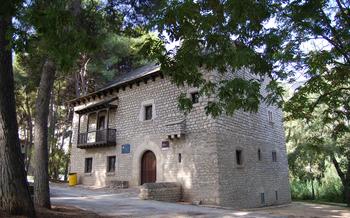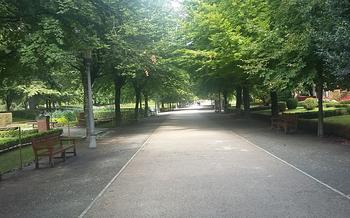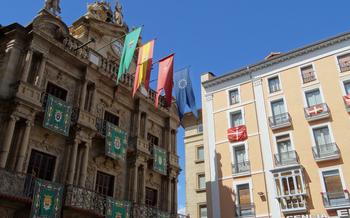
Arbayun Nature Reserve (Reserva Natural de la Foz de Arbayún)
- The Arbayun Nature Reserve
- Hiking Trails and Routes
- The Foz de Arbayún Gorge
- Wildlife and Birdwatching
- Caves and Rock Formations
- Flora and Vegetation
- Visitor Centers and Facilities
- Accommodations and Dining
- Best Time to Visit
- Transportation and Getting There
- Safety and Precautions
- Responsible Tourism
- Insider Tip: Unveiling the Hidden Gems of Arbayún Nature Reserve
The Arbayun Nature Reserve
The Arbayun Nature Reserve (Reserva Natural de la Foz de Arbayún) is a stunning natural wonder located in northern Spain, within the autonomous community of Navarre. Gazetted as a protected area in 1987, the reserve encompasses a breathtaking gorge carved by the Aragon River, along with diverse landscapes that include forests, cliffs, and grasslands.
Geographically, the reserve is situated in the Pre-Pyrenees mountain range, with the Foz de Arbayún gorge serving as its centerpiece. The gorge is accessible by a scenic road that winds its way through the rugged terrain, offering panoramic views of the surrounding countryside. The reserve's unique geological formations, including impressive rock walls and caves, have been shaped over millions of years by the erosive forces of the river.
The Arbayun Nature Reserve boasts a rich biodiversity, with a variety of flora and fauna calling it home. The reserve's diverse habitats support a wide range of plant species, including Mediterranean vegetation, forests of holm oaks and Aleppo pines, and subalpine grasslands at higher elevations. The reserve is also home to a variety of animal species, including birds of prey such as vultures, eagles, and falcons, as well as mammals such as mountain goats, wild boar, and foxes.
Hiking Trails and Routes
The Arbayun Nature Reserve offers a diverse network of hiking trails, catering to hikers of all levels and interests. Whether you're a seasoned trekker or a casual nature enthusiast, there's a trail tailored to your abilities and preferences.
The reserve encompasses a range of trails, varying in difficulty from easy, family-friendly paths to challenging treks for experienced hikers. Each trail is well-marked and maintained, ensuring a safe and enjoyable hiking experience.
Along the trails, you'll be rewarded with breathtaking scenic viewpoints and panoramic vistas. The reserve's elevated terrain provides stunning views of the surrounding landscapes, including the majestic Pyrenees mountains in the distance.
Before embarking on your hike, be sure to check the trail conditions and obtain any necessary permits or information from the visitor center. Remember to wear appropriate footwear and clothing, bring sufficient water and snacks, and be prepared for changing weather conditions.
The Foz de Arbayún Gorge
The Foz de Arbayún Gorge, the centerpiece of the reserve, is a breathtaking natural wonder formed by the erosive power of the Aragón River over millions of years. This narrow passageway, with its towering limestone cliffs and lush vegetation, creates a unique and awe-inspiring landscape.
The gorge stretches for about 5 kilometers, with a width that varies from just a few meters to over 100 meters. The river Aragón, which flows through the gorge, adds to its charm, creating a symphony of sounds and reflections.
The Foz de Arbayún is not only a geological marvel but also holds cultural and historical significance. It was once an important route for trade and communication between the regions of Navarra and Aragon. Evidence of human presence in the gorge dates back to prehistoric times, with cave paintings and archaeological remains found within its walls.
In addition to its natural beauty and historical importance, the Foz de Arbayún Gorge is a haven for wildlife. The diverse habitats within the gorge support a variety of plant and animal species, including birds of prey, vultures, mountain goats, and other wildlife.
Wildlife and Birdwatching
The Arbayun Nature Reserve is a haven for wildlife enthusiasts and birdwatchers. The reserve is home to a diverse range of bird species, including several migratory species that pass through the area during the spring and fall seasons. Raptors such as griffon vultures, golden eagles, and Egyptian vultures soar gracefully above the cliffs and canyons, while smaller birds like rock thrushes, blue tits, and Sardinian warblers flit among the trees and shrubs.
In addition to birds, the reserve is also home to a variety of mammals, including wild boar, roe deer, and mountain goats. These animals can often be spotted grazing in the meadows or resting in the shade of the trees. The reserve also provides an important habitat for a variety of reptiles and amphibians, including lizards, snakes, and frogs.
The reserve is committed to protecting the wildlife within its boundaries and promoting responsible wildlife viewing practices. Visitors are encouraged to observe wildlife from a distance and avoid disturbing their natural behaviors. The use of binoculars and spotting scopes is recommended for getting a closer look at the animals without causing any harm.
Caves and Rock Formations
Within the Arbayún Nature Reserve, you'll find several notable caves and rock formations that hold significant historical and geological importance. One must-see cave is the Cueva de San Miguel, an impressive underground complex with a series of chambers and galleries. It's home to ancient cave paintings and archaeological discoveries that shed light on the region's prehistoric past.
Another highlight is the Cueva de las Güixas, also known as the "Witches' Cave," which features stunning rock formations and a unique atmosphere. Its name originates from local legends and folklore associated with the area.
As you explore the reserve, keep an eye out for unique rock formations that have been shaped by centuries of erosion, creating intriguing and picturesque landscapes. These natural sculptures offer a glimpse into the geological processes that have shaped this region.
When exploring caves, always prioritize safety. Use proper lighting and equipment and be aware of potential hazards such as slippery surfaces and tight passages. Respect the natural environment and avoid disturbing wildlife or damaging fragile formations.
Flora and Vegetation
The Arbayun Nature Reserve boasts a diverse array of plant life, showcasing the rich Mediterranean vegetation that thrives in this unique ecosystem. From towering trees to delicate wildflowers, the reserve offers a kaleidoscope of colors and textures that delight the senses.
Endemic and Rare Plant Species
Among the botanical wonders found within the reserve are several endemic and rare plant species that contribute to its ecological significance. These unique plants, found nowhere else in the world, are carefully protected and studied by botanists and conservationists.
Seasonal Variations and Colorful Displays
The changing seasons bring about a vibrant transformation in the Arbayun Nature Reserve. In spring, the hillsides burst into life with a tapestry of wildflowers, including orchids, lilies, and poppies. As summer progresses, the landscape transforms into a verdant oasis, with lush greenery carpeting the valleys and slopes.
Conservation Initiatives and Sustainable Practices
The Arbayun Nature Reserve is committed to preserving its delicate ecosystem and promoting sustainable practices. Conservation efforts focus on protecting endangered plant species, restoring degraded habitats, and educating visitors about the importance of responsible tourism. Visitors are encouraged to tread lightly, minimize their impact on the environment, and support local conservation initiatives.
Visitor Centers and Facilities
Within the reserve, there are several visitor centers and facilities to enhance the experience of nature enthusiasts and visitors. The main information point is the Centro de Interpretación de la Foz de Arbayún, located in the town of Arbayún. This center provides informative exhibits and displays about the reserve's natural and cultural heritage, including interactive displays and guided tours.
Throughout the reserve, there are also several other information points and interpretive centers, such as the Aula de la Naturaleza de La Espartosa and the Centro de Interpretación de la Reserva Natural de la Foz de Lumbier. These centers offer maps, brochures, and educational exhibits, helping visitors understand the unique features of the reserve and its conservation efforts.
To ensure accessibility for visitors with disabilities, many of the trails and facilities within the reserve have been adapted for wheelchair users and individuals with reduced mobility. Visitors can inquire about accessible routes and facilities at the information centers or through the reserve's official website.
Accommodations and Dining
When planning your adventure in the Arbayún Nature Reserve, consider the charming towns and villages that surround it for your lodging needs. Each village offers its own unique charm and character, allowing you to immerse yourself in the local culture. Enjoy traditional Spanish cuisine in local restaurants, savoring the flavors of the region. For a more immersive experience, pack a picnic lunch and find a secluded spot within the reserve to enjoy your meal surrounded by nature's beauty. Designated picnic areas are available for your convenience, ensuring a comfortable and enjoyable dining experience. If you prefer camping, there are designated campsites within the reserve where you can pitch your tent and experience the tranquility of nature under the starry sky. Remember to follow responsible camping practices, respecting the environment and leaving no trace of your stay.
Best Time to Visit
The best time to visit the Arbayun Nature Reserve depends on your interests and preferences. If you're a birdwatcher, spring and early summer (April to June) are ideal for spotting migratory species and nesting birds. For hiking and outdoor activities, late spring (May) and autumn (September to October) offer pleasant temperatures and fewer crowds.
Summer (July and August) can be hot and dry, but it's still a great time to enjoy the reserve's natural beauty. Just be sure to bring plenty of water and sunscreen. Winter (November to March) brings cooler temperatures and occasional snowfall, making it a quieter time to visit. However, some trails may be inaccessible due to snow and ice.
To avoid the crowds, try to visit during the weekdays or early in the morning. The reserve is generally less crowded during the shoulder seasons (spring and autumn) compared to the peak summer months. If you're planning a weekend visit, arrive early to secure a parking spot.
Transportation and Getting There
Reaching the Arbayun Nature Reserve is a breeze, with various transportation options available. For those without their own set of wheels, public transportation provides a convenient alternative. Buses run regularly from Pamplona and other nearby towns, dropping you off at the gateway to the reserve.
If you prefer the flexibility of driving, the reserve is easily accessible by car. Follow the signs from Pamplona or Sangüesa, and you'll find ample parking spaces at the visitor center. Remember to arrive early during peak season to avoid the rush.
Organized tours are another great way to explore the reserve, especially if you're short on time or prefer a guided experience. These tours typically include transportation from major cities like Pamplona or Zaragoza and often combine the reserve visit with other nearby attractions.
For a truly eco-friendly adventure, consider hopping on a bicycle. The reserve's trails are well-suited for cycling, and you'll have the added bonus of immersing yourself in the tranquility of the natural surroundings as you pedal along.
Safety and Precautions
Venturing into the Arbayún Nature Reserve requires careful consideration of safety measures. Follow these guidelines to ensure a safe and enjoyable experience:
-
Proper Footwear and Clothing: Wear comfortable, sturdy hiking boots or shoes with good ankle support. Dress in layers to adjust to changing weather conditions, and bring a waterproof jacket or poncho in case of rain.
-
Water and Hydration: Pack an adequate supply of water, especially during hot weather or extended hikes. Staying hydrated is crucial for your well-being.
-
Respect Wildlife: Observe wildlife from a distance and avoid disturbing their habitats. Do not approach or feed animals, as they may react unpredictably.
-
Avoid Wildlife Encounters: Be aware of your surroundings and make noise while hiking to avoid surprising animals. Carry a whistle or other noise-making device to deter wildlife encounters.
-
Stay on Marked Trails: Stick to designated trails to minimize disturbance to the natural environment and avoid getting lost.
-
Check Weather Conditions: Before embarking on your hike, check the weather forecast and be prepared for sudden changes in conditions.
-
Inform Others of Your Plans: Let someone know your hiking route and expected return time, especially if you're venturing into remote areas.
-
Carry a Map and Compass: Bring a map of the reserve and a compass for navigation, even if you're using a GPS device.
-
Stay Alert and Aware: Be mindful of your surroundings and potential hazards like loose rocks, slippery surfaces, or steep drop-offs.
Responsible Tourism
As you embark on your journey through the Arbayun Nature Reserve, it's crucial to embrace responsible tourism practices that minimize your environmental impact and support the local community. Follow the Leave No Trace principles by packing out all your waste and avoiding disturbing wildlife. Respect local customs and traditions, and opt for sustainable tourism initiatives that give back to the region. By supporting local businesses, using eco-friendly transportation, and choosing accommodations that prioritize sustainability, you can contribute to the preservation of this natural paradise for generations to come. Remember, responsible tourism is not just about what you do but also how you do it.
Insider Tip: Unveiling the Hidden Gems of Arbayún Nature Reserve
Beyond the well-trodden paths of the Arbayún Nature Reserve, there lies a realm of hidden wonders waiting to be discovered. For the intrepid traveler seeking solitude and unique experiences, venturing off the beaten track will reveal a treasure trove of natural wonders. Secluded viewpoints offer breathtaking panoramas, while lesser-known trails lead to hidden waterfalls, pristine pools, and ancient cave dwellings. Engage with the local community to uncover the region's rich traditions, savor authentic cuisine in family-run restaurants, and immerse yourself in the vibrant festivals that celebrate the region's heritage. Embrace the opportunity to become a responsible traveler, treading lightly on the land and leaving only footprints behind. As the sun dips below the horizon, the reserve transforms into a celestial wonderland. Stargazing enthusiasts will be mesmerized by the unpolluted night sky, where constellations dance and meteors streak across the canvas above. With a little luck, you might even catch a glimpse of the elusive nocturnal wildlife that emerges under the cloak of darkness.
